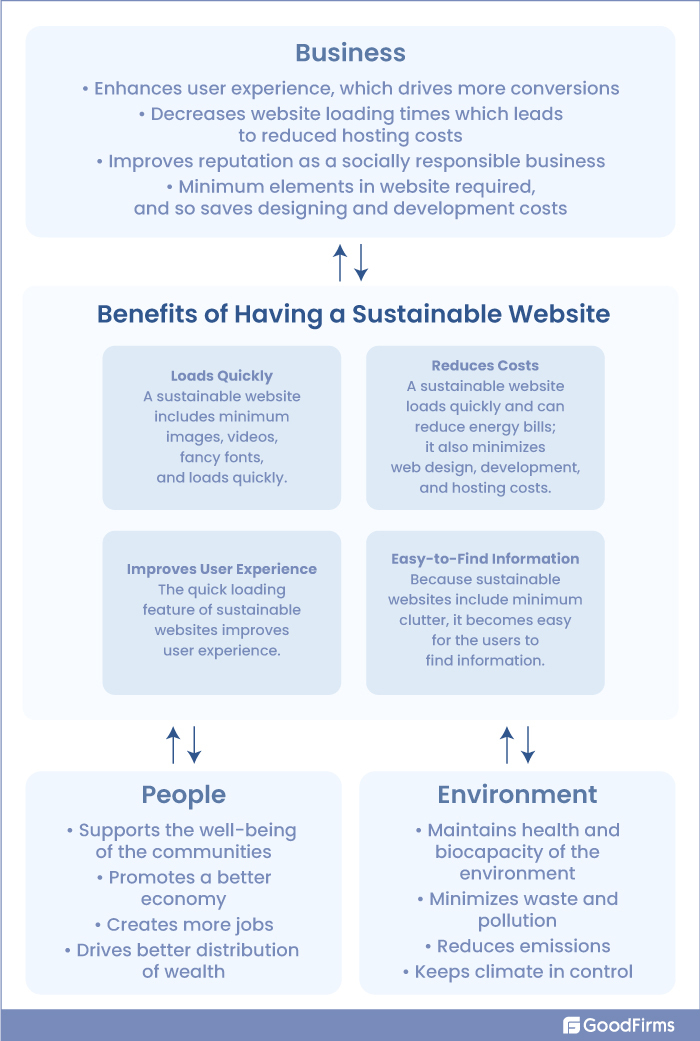It might seem surprising that the internet also impacts the environment, triggers climate change, and harms our planet and people, similar to burning fossil fuels, deforestation, overpopulation, pollution, etc. The solution to this problem is - "sustainable web design," which is an approach to designing websites that load quickly, are user-friendly, informative, genuine, and consume the least amount of energy.
"If the internet were an actual country, it would be the sixth-largest polluting country in the world."- Tom Greenwood (cofounder of U.K.'s Wholegrain Digital web design agency).
To reduce the carbon footprint caused due to the internet, many socially responsible enterprises are now inclining toward using advanced web design tools that help them design sustainable websites suitable for people and the planet. A website is considered eco-friendly when it is uncluttered, well-organized, easily searchable & accessible, and includes authentic information that adds value to the users and the businesses.
Moreover, owning a sustainable website enables enterprises to fulfill their corporate social responsibilities toward making the world a better place to live and, at the same time, improve their online presence and provide a seamless browsing experience to their visitors.
This article provides complete information about sustainable web design in detail, and its positive impact on the environment, business, and global economy at present and in the future, which eventually leads to the fact that the demand for sustainable web design is only going to increase.
What is Sustainable Web Design?
Sustainable web design, also known as eco-friendly web design, consumes the minimum energy possible and is good for both the environment and people. A sustainable website gets loaded with speed as it uses only necessary images that are well optimized in terms of dimension and resolution. It also includes minimum duration videos that get downloaded quickly. Precisely, a fast-loading website that is easy to navigate and is search engine friendly is termed a sustainable website.
Designing a sustainable web design means following certain practices that decrease web page loading times, gain better SEO rankings, and deliver excellent user experiences. Also, the companies that own sustainable websites are perceived as more socially responsible than those that don't. Thus, they are likely to build more trust over their customers, gain a competitive advantage, and improve their bottom line.
Though the field of sustainable web design is still in its infancy, there are many groups now who have been working on this and creating energy-efficient websites and processes. A recently formed organization known as The Green Web Foundation focuses on a vision for a fossil-free internet by 2030. Also, many tech companies are working towards achieving carbon neutrality and zero emissions.
Let’s have a look at the below six characteristics of a sustainable website.

So, does your website have these traits? Is your website sustainable? Let's have a look at how much energy your website uses.
How Much Energy Does a Website Use?
To check how much energy a website uses, we checked our website Goodfirms.com using the Ecograder, which can tell you how eco-friendly your website is based on its visitors per month, and below are the results.

Similarly, you can also check how eco-friendly your website is and consider the below-mentioned practices to make it more sustainable to benefit your website visitors, the environment, and your business.
Best Practices That Make Your Website Sustainable
When it comes to making a website sustainable, three prominent aspects need to be taken care of - Design & Content, Development, and Hosting. Let's dive into the details.

#1 Design & Content
The design & content of a website plays a significant role in building a sustainable website. Below are some factors related to the design and content of a website to ensure its sustainability.
A. Minimize Images
A slower loading web page due to the images embedded within consumes more energy. So, to make a website sustainable, content creators and designers should consider reducing the number of images and their size wherever possible. A website that uses images carefully is likely to load faster, consume less energy, and prove to be beneficial for the environment.
B. Reduce Videos
Videos take more time to load than images and make a website heavy and time-consuming to load. Ask yourself - are videos essential? If not, it can be removed. Also, the video content can be kept short, and autoplay should be turned off so that the users get control over whether to view a video or not.
C. Select Fonts Carefully
Using attractive fonts can enhance the visual appeal of websites but can add significant weight and add to the loading time. Moreover, this adds up if the fonts are bold. Using standard fonts like Ariel and Times New Roman may not look aesthetically beautiful. Still, it can make the entire website sustainable as they are present in every system and do not require loading any additional font files.
D. Implement SEO Practices
SEO might not seem to connect with website efficiency directly, but implementing SEO practices can help you design a lighter website that loads quickly. Indirectly, SEO reduces the time people spend browsing websites and finding information, which contributes to less energy consumption. Also, it enables relevant information to rank higher in search engines, ultimately allowing people to find what they are looking for easily.
E. Write Comprehensive Content
The content on the website is too ambiguous; people are likely to spend more time and energy searching for the information they exactly require. Keep the navigation simple and content that is easy to understand, which adds value to the business and your website visitors. Clear and efficient copywriting can help in reducing the time and energy wasted on the internet and contribute to a greener planet.
All the above aspects that come under the design & content of the website enhance the user experience, which eventually leads to better conversions and business growth. So, a sustainable website is not only beneficial to the planet but also impacts business growth to a great extent.
#2 Development
Optimizing the design and content of the website plays a vital role in making a website sustainable but still has many limitations which developers can control. Let's look at those web development areas that can contribute to building a sustainable website.
A. Include Ability to Cache Files
The webpage you develop should have the ability to cache files on users' devices resulting in quick loading of content and images during repetitive visits. This reduces the amount required by repeat visitors to browse the website, especially on mobile devices where energy consumption is more than on wired devices.
B. Apply Accelerated Mobile Pages (AMP)
AMP is a technology that makes content load quicker on mobile devices by removing unnecessary code and delivering a lighter version of the original web page. Google also prioritized AMP-powered websites in search results for news-related topics to improve the website's visibility in search results.
C. Write Clean Code
Your website's overall code should be refined and customized efficiently to deliver the functionality you need. Writing streamlined and tidy codes is a fundamentally good practice. But, when you are borrowing code from external sources and libraries at that time, you also need to avoid duplications and ensure efficiency in queries.
D. Choose Static Over CMS
Creating static web pages using HTML, CSS, and JS can make your website energy-efficient. CMS helps build web pages quicker, but it causes the server to utilize more energy. On the contrary, static web pages with no database load quickly as they don't require the web server to process the information to be displayed on the front end.
E. Use Javascript Efficiently
Functionality achieved by Javascript is processed on computers or phones, thus increasing CPU usage, leading to the higher energy consumption of the devices. Ask yourself if that functionality adds value to the user experience and impacts conversions or not. Suppose not can avoid using JS for that functionality.
#3 Web Hosting
A tremendous amount of energy is consumed in data transmission, and this is where web hosting comes into the picture. To carefully consider web hosting for your website to maintain the sustainability of your website, the below-mentioned points should be taken care of -
A. Apply Server Caching
Applying server caching techniques can help pre-generate static versions of each dynamic page, reducing the server overheads for repeated visitors. This helps minimize server energy consumption and makes a big difference when it comes to hosting a sustainable website.
B. Select Web Hosting with High PUE Ratings
Data centers are usually rated for energy efficiency using a metric known as PUR (Power Usage Efficiency). The PUE is measured based on energy used to run the computers within the data center and wasted on non-computational activities like cooling. For example, Google is known to use the most energy-efficient data centers with an average of 1.10 PUE.
C. Host a Website in a Data Center Close to your Audience
A huge amount of energy is utilized by the internet that is used to transmit data using different telecom networks. The more distance the data travels, the more energy it uses in its journey. Therefore, determining the location of your data center becomes critical for energy efficiency. A website hosted in a data center close to your target audience can benefit user experience and improve eco-friendliness.
So, now you know the steps to be taken in terms of website designing, development, and hosting that benefit your organization, customers, and environment at the same time.
The way a website is built and hosted can decide how sustainable it is. Especially when there are a huge number of visitors visiting your website every day, creating better websites can be a crucial step towards minimizing your company's carbon footprint.
Brands today feel it is necessary to communicate their efforts towards making their website sustainable. That helps them enhance their reputation in front of the audiences who want to deal only with those companies wanting to save the planet from carbon emissions.
To better understand about sustainable web design, let's have a look at why website sustainability is worth considering these days, regardless of the type or size of your business -
Why Is Website Sustainability Important?
In this digitally transformed era, it is evident that the number of internet users is constantly increasing, leading to more carbon emissions, and adversely impacting the environment. Thus, to save the environment, building a sustainable website becomes significant. Not only that, but sustainable websites are also crucial for people and businesses. Let's look at some aspects that clearly demonstrate the significance of eco-friendly websites, proving that website sustainability should be a part of our global business practices.
Environment-Friendly
Sustainable websites are built using minimum resources and renewable energy. This helps in maintaining the balance between the amount of resources produced by the earth and amount of resources used by humans. Thus, sustainable websites play a significant role in reducing the ecological footprint, maintaining the earth's biocapacity, and keeping the planet green and healthy.
Efficiency
Sustainable websites are lighter with the right code and the right size of images and videos. So, these websites get loaded quickly, saving users' time, money, and energy. Precisely, sustainability in websites can improve the efficiency of the overall business and, at the same time, minimize the harmful side effects of the internet on people and the environment.
Findability
Following a systematic approach towards building a sustainable website, fortunately, matches with SEO practices, and so a sustainable website becomes an SEO-friendly website. An SEO-friendly website is naturally likely to have more potential to rank higher in search engines and be easily found by prospective customers. Higher search engine rankings lead to improved business growth and revenue generation.
Beyond a doubt, the internet has made our lives easier, but its mass consumption creates environmental problems. To reduce the internet's carbon footprints; implementation of sustainable web design practices has become essential and thus is being highly adopted by socially responsible enterprises these days.
Sustainability in websites benefits everyone, including the environment, website users (people), and businesses. Let's have a look at those benefits in detail.

After knowing how beneficial a sustainable website is to the environment, people, and business, let's look at what the future holds for website sustainability and its impact on the digital industry as a whole.
The Future of Sustainable Web Design
We all are experiencing the negative impacts of climate change which are becoming more evident and prominent day by day. Because of that, people are inclined towards adopting technologies that promote sustainability, helping them minimize waste of resources and energy and contributing to a greener planet. The future of sustainable websites won't depend on a single practice or technology. Instead, it will depend on how the brands come together in this movement and make a difference toward a greener planet.
Modern companies now know that the planet's overall health positively impacts their business by bringing in more customers and improving their reputation. This is why many companies like Amazon are shifting toward a net-zero carbon future and building sustainable businesses for their customers, employees, and communities.This eCommerce giant has co-founded The Climate Pledge, which is committed to achieving net-zero carbon emissions by 2040.
Moreover, as the annual global energy consumed by the internet will rise from 10% to 20% in 2030, it is high time that we start thinking about saving our planet and making our websites more sustainable.
It is an inevitable fact that our economic activities are getting digital. From grocery shopping to transferring funds, everything is being done online. In that context, the internet's contribution to world climate pollution will only increase and never decrease. Thus, it becomes the responsibility of the brands who have contributed to the internet's infrastructure to reduce carbon emissions and stop environmental damage. The socially responsible companies delivering sustainable user experience are likely to grow their clientele and progress towards increased revenue and expansion.
Conclusion
Thus, following the practices that can help in building sustainable websites help immensely in reducing the energy consumption that the people require to browse the web and comprehend the online content. A sustainable website can also help you boost user experience and usability, resulting in better performance in search engine rankings and eventually impacting the conversion rate and revenue generation.
So, as the demand for sustainable web design is only going to increase, it becomes significant to consider heading towards an eco-friendly route. Using the right website builder software and web hosting software with effective web design sustainability and SEO practices can only help you achieve your predetermined business goals and stay ahead of the competition.


